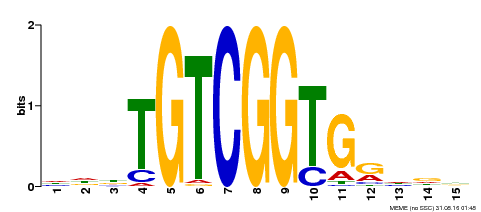 |
PlantRegMap/PlantTFDB v5.0
Plant Transcription
Factor Database
|
| Home TFext BLAST Prediction Download Help About Links PlantRegMap |
Transcription Factor Information
| Basic Information? help Back to Top | |||||||||
|---|---|---|---|---|---|---|---|---|---|
| TF ID | Vang04g13430.5 | ||||||||
| Common Name | LR48_Vigan03g168800 | ||||||||
| Organism | |||||||||
| Taxonomic ID | |||||||||
| Taxonomic Lineage |
cellular organisms; Eukaryota; Viridiplantae; Streptophyta; Streptophytina; Embryophyta; Tracheophyta; Euphyllophyta; Spermatophyta; Magnoliophyta; Mesangiospermae; eudicotyledons; Gunneridae; Pentapetalae; rosids; fabids; Fabales; Fabaceae; Papilionoideae; Phaseoleae; Vigna
|
||||||||
| Family | ERF | ||||||||
| Protein Properties | Length: 188aa MW: 20775.8 Da PI: 4.4342 | ||||||||
| Description | ERF family protein | ||||||||
| Gene Model |
|
||||||||
| Signature Domain? help Back to Top | |||||||
|---|---|---|---|---|---|---|---|
| No. | Domain | Score | E-value | Start | End | HMM Start | HMM End |
| 1 | AP2 | 47 | 6.3e-15 | 3 | 45 | 11 | 56 |
AP2 11 krgrWvAeIrdpsengkrkrfslgkfgtaeeAakaaiaarkklege 56
+g+Wv+eIr+p++ + r++lg++ tae+Aa+a++ a+++++g+
Vang04g13430.5 3 AWGKWVSEIREPRK---KSRIWLGTYPTAEMAARAHDVAALAIKGH 45
6**********843...6***********************99986 PP
| |||||||
| Protein Features ? help Back to Top | ||||||
|---|---|---|---|---|---|---|
| Database | Entry ID | E-value | Start | End | InterPro ID | Description |
| PROSITE profile | PS51032 | 19.928 | 1 | 52 | IPR001471 | AP2/ERF domain |
| Gene3D | G3DSA:3.30.730.10 | 1.8E-26 | 1 | 53 | IPR001471 | AP2/ERF domain |
| SMART | SM00380 | 2.4E-28 | 1 | 58 | IPR001471 | AP2/ERF domain |
| CDD | cd00018 | 6.99E-28 | 1 | 54 | No hit | No description |
| SuperFamily | SSF54171 | 8.5E-18 | 2 | 53 | IPR016177 | DNA-binding domain |
| Pfam | PF00847 | 9.3E-10 | 3 | 45 | IPR001471 | AP2/ERF domain |
| Gene Ontology ? help Back to Top | ||||||
|---|---|---|---|---|---|---|
| GO Term | GO Category | GO Description | ||||
| GO:0006355 | Biological Process | regulation of transcription, DNA-templated | ||||
| GO:0005634 | Cellular Component | nucleus | ||||
| GO:0003700 | Molecular Function | transcription factor activity, sequence-specific DNA binding | ||||
| GO:0044212 | Molecular Function | transcription regulatory region DNA binding | ||||
| Sequence ? help Back to Top |
|---|
| Protein Sequence Length: 188 aa Download sequence Send to blast |
MRAWGKWVSE IREPRKKSRI WLGTYPTAEM AARAHDVAAL AIKGHSAYLN FPNLAQDLPR 60 PITTSPKDIQ AAAAKAATTF FDDGKRCEAE KDEQNHTEQA SSSTLCMENT EVEQVQAEEA 120 SPSTLSMDTT QGSSTSHSTA DDDTLFDLPD LFPDGNNGLF FSYSSSWHLC AADSGFRLEE 180 QFLWENY* |
| Functional Description ? help Back to Top | ||||||
|---|---|---|---|---|---|---|
| Source | Description | |||||
| UniProt | Probably acts as a transcriptional activator. Binds to the GCC-box pathogenesis-related promoter element. May be involved in the regulation of gene expression by stress factors and by components of stress signal transduction pathways (By similarity). {ECO:0000250}. | |||||
| Binding Motif ? help Back to Top | |||
|---|---|---|---|
| Motif ID | Method | Source | Motif file |
| MP00312 | DAP | Transfer from AT2G44940 | Download |

| |||
| Cis-element ? help Back to Top | |
|---|---|
| Source | Link |
| PlantRegMap | Vang04g13430.5 |
| Regulation -- PlantRegMap ? help Back to Top | ||||||
|---|---|---|---|---|---|---|
| Source | Upstream Regulator | Target Gene | ||||
| PlantRegMap | Retrieve | Retrieve | ||||
| Annotation -- Nucleotide ? help Back to Top | ||||||
|---|---|---|---|---|---|---|
| Source | Hit ID | E-value | Description | |||
| GenBank | AP015037 | 0.0 | AP015037.1 Vigna angularis var. angularis DNA, chromosome 4, almost complete sequence, cultivar: Shumari. | |||
| Annotation -- Protein ? help Back to Top | |||||||
|---|---|---|---|---|---|---|---|
| Source | Hit ID | E-value | Description | ||||
| Refseq | XP_017418094.1 | 1e-140 | PREDICTED: ethylene-responsive transcription factor ERF034 | ||||
| Swissprot | Q8LBQ7 | 2e-57 | ERF34_ARATH; Ethylene-responsive transcription factor ERF034 | ||||
| TrEMBL | A0A0L9U6A8 | 1e-139 | A0A0L9U6A8_PHAAN; Uncharacterized protein | ||||
| TrEMBL | A0A0S3RVU0 | 1e-139 | A0A0S3RVU0_PHAAN; Uncharacterized protein | ||||
| STRING | XP_007140776.1 | 1e-111 | (Phaseolus vulgaris) | ||||
| Best hit in Arabidopsis thaliana ? help Back to Top | ||||||
|---|---|---|---|---|---|---|
| Hit ID | E-value | Description | ||||
| AT2G44940.1 | 7e-47 | ERF family protein | ||||
| Publications ? help Back to Top | |||
|---|---|---|---|
|
|||



